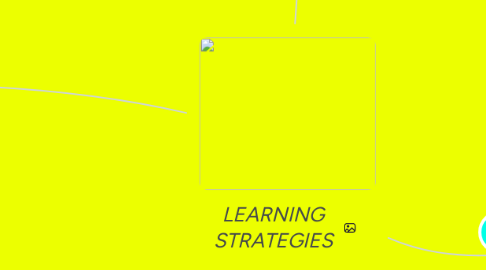
1. INDIRECT STRATEGIES
1.1. Are used for general management of learning
1.1.1. They help learner regulate the learning process
1.1.2. support and manage language learning without direct engagement and therefore called indirect strategies.
1.2. METACOGNITIVE STRATEGIES
1.2.1. Coordinate the learning process
1.2.1.1. Delimit what is going to be learned
1.2.1.2. Sort and plan what to learn
1.2.1.3. Evaluate learning, analyzing problems and finding solutions
1.2.2. Go beyond the cognitive mechanism and give learners to coordinate their learning.
1.2.2.1. This helps them to plan language learning in an efficient way
1.2.2.2. When new vocabulary, rules, and writing system confuse the learner, these strategies become vital for successful language learning
1.2.3. Three sets of strategies belong to this group and they are
1.2.3.1. Centering Your Learning
1.2.3.1.1. The aim of centering learning is to give a focus to the learner so that the attention could be directed toward certain language activities or skills.
1.2.3.2. Arranging and Planning Your Learning
1.2.3.2.1. Arranging and planning learning help learners to organize so they may get maximum benefit from their energy and effort.
1.2.3.3. Evaluating Your Learning
1.2.3.3.1. Evaluating learning helps learners with problems like monitoring errors and evaluation of progress.
1.3. AFFECTIVE STRATEGIES
1.3.1. Regulate emotions
1.3.1.1. Reduce Anxiety
1.3.1.2. Buck up
1.3.1.3. Controlling emotions
1.3.2. The affective factors
1.3.2.1. Emotion
1.3.2.2. Attitudes
1.3.2.3. Motivation,
1.3.2.4. Value
1.3.3. Three sets of strategies are included in this group
1.3.3.1. Lowering Your Anxiety
1.3.3.1.1. It is felt that a certain amount of anxiety is helpful for learners because it helps them obtain their optimum level of performance
1.3.3.1.2. Too much anxiety has the opposite effect where it hinders language learning
1.3.3.2. Encouraging Yourself
1.3.3.3. Taking Your Emotional Temperature
1.3.4. TEACHERS
1.3.4.1. Generate positive feeling in class
1.3.4.1.1. Responsibility
1.3.4.1.2. Increasing the amount of natural communication
1.3.4.1.3. Teaching affective strategies
1.4. SOCIAL STRATEGIES
1.4.1. For the student to learn with the increasing their level of interaction with target language
1.4.1.1. Request clarifications, verifications or repetitions
1.4.1.2. Interact with native speakers and native speaker
1.4.1.3. Empathize with others
1.4.2. Social strategies are very important in learning a language because language is used in communication and communication occurs between people
1.4.3. Three sets of strategies are included in this group
1.4.3.1. Asking Questions
1.4.3.1.1. Is the most helpful and comes closest to understanding the meaning
1.4.3.1.2. Helps in conversation by generating response from the partner and shows interest and involvement
1.4.3.2. Cooperating with others
1.4.3.2.1. Eliminates competition and in its place brings group spirit
1.4.3.2.2. Studies show that cooperative learning results in higher self-esteem, increased confidence, and rapid achievement
1.4.3.3. Empathizing with Others
1.4.3.3.1. Means to put oneself in someone elses situation to understand that persons point of view
1.4.3.3.2. Learners can use social strategies to develop cultural understanding and become aware of thoughts and feelings of others.
2. WHAT IS ?
2.1. Organized mental systems or procedures that the student consciously chooses and uses respond a particular learning situation in order achieve the objectives.
2.1.1. O' Malley, Chamot, and Kupper
2.1.1.1. effective listeners used three specific strategies
2.1.1.1.1. Self-monitoring
2.1.1.1.2. Elaboration
2.1.1.1.3. Inferences
2.1.1.2. Ineffective listeners
2.1.1.2.1. Meaning of individual words
3. DIRECT STRATEGIES
3.1. The strategies used directly in dealing with a new language
3.1.1. STUDENTS
3.1.1.1. Are beneficial to the students because they help store and recover information.
3.1.1.2. Produce language even when there is gap in knowledge.
3.1.1.3. Understand and use the new language.
3.2. Memory strategies
3.2.1. Simple principles
3.2.1.1. Lay things out in order
3.2.1.2. Reviewing
3.2.1.3. Making association
3.2.2. For retain and remember the new information
3.2.2.1. Create Mental Associations
3.2.2.2. Associate images and sounds
3.2.2.3. Give physical responses
3.2.3. Students
3.2.3.1. The words and phrases can be associated with visual images that can be stored and retrieved for communication
3.2.3.1.1. A learner brings own life experience to interpret data by guessing
3.2.3.1.2. Compensation strategies are also used in production when grammatical knowledge is incomplete
3.2.3.2. Make use of visual images, but some find it easy to connect words and phrases with sound, motion or touch.
3.2.3.3. The tools of receiving and sending messages are used when learners try to find the main idea through skimming and scanning.
3.2.3.3.1. These are used to understand the meaning and expression of the target language
3.2.3.3.2. It is not necessary to check every word
3.2.3.3.3. These are also used to make new expressions.
3.3. COGNITIVE STRATEGIES
3.3.1. For make sense of learning and to produce the language
3.3.1.1. Practice the communicative contents
3.3.1.2. Encode and decode messages
3.3.1.3. Analyze and reason
3.3.1.4. Utilizar recursos para organizar la información y poder utilizarla
3.3.2. The four sets in this group are
3.3.2.1. Practicing
3.3.2.2. Receiving and Sending Messages
3.3.2.3. Analyzing and Reasoning
3.3.2.4. Creating Structure for Input and Output.
3.3.3. The target
3.3.3.1. Is manipulated or transformed by repeating
3.3.3.2. Analyzing or summarizing
3.3.4. STUDENTS
3.3.4.1. Practicing is the most important in this group which can be achieved by repeating, working with sounds and writing, and using patterns
3.3.4.1.1. The tools of receiving and sending messages are used when learners try to find the main idea through skimming and scanning
3.3.4.1.2. It is not necessary to check every word
3.3.4.2. The adult learners commonly use analyzing and reasoning strategies
3.3.4.2.1. These are also used to make new expressions.
3.4. COMPENSATION STRATEGY
3.4.1. To help students overcome gaps knowledge to continue communication
3.4.1.1. Guess the meaning
3.4.1.2. Solve communication problems
3.4.2. Estudents
3.4.2.1. For comprehension of the target language when they have insufficient knowledge of the target language
3.4.2.2. These strategies make up for the deficiency in grammar and vocabulary
3.4.2.3. When learners do not know new words and expressions, they guess the meaning.
3.4.2.4. A learner brings own life experience to interpret data by guessing
